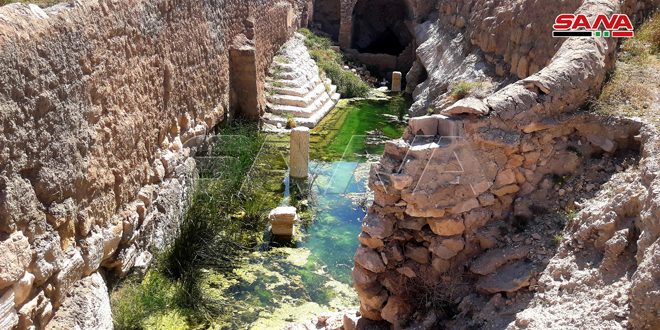Afqa spring returns to flow in the center Syrian al-Badia

Palmyra, SANA-Afqa Spring, which is located in one of the most important Syrian archaeological sites, has returned to flow and breathe life into the veins of the vineyards of the archaeological area’s Oasis in Palmyra city in the center of the Syrian semi-desert.
The historic Afqa Spring is a water spring and an archaeological cave carved into the rocks since 6 thousand years ago, it is also considered an important tourist landmark that returned life to the palm and olive trees.
It is located in the southwestern part of Palmyra, and its water flows from the depth of al-Mintar mount from a 400-meter-long cave, in which water flows out of 9 natural underground wells dug in the limestone rock.
The spring has gained great importance because its water is mineral and sulfuric and has a constant temperature in all seasons (33 degrees Celsius) and this water is useful in healing the skin diseases, anemia cases, removing sandy materials from the urinary system, and liver illnesses by sulfur and radiotherapy which activate the liver and kidney cells.
It irrigates trees of the oasis in the middle of Palmyra, and the local residents depend on it as their main source of livelihood before Daesh terrorist organization invaded the city in 2015, causing a lot of destruction and the spring was exposed to drought and most of the oasis trees were burned and dried up.
It was an important initiative when a Syrian-Russian team rehabilitated the historic Afqa spring in Palmyra under the supervision of the General Directorate of Antiquities and Museums in Syria, so its water began to flow to irrigate the trees of the Palmyra orchards, which is 420 hectares and includes about 200,000 palm trees and more than 300,000 olive trees.
Rehabilitation of the spring will also have a positive impact in increasing the expected production of dates.
Fedaa al-Rhayiah/ Mazen Eyon








